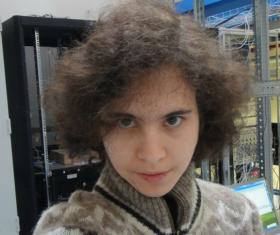Daria Betsis, a student of the 5th year of the Chair of the General Nuclear Physics (MSU Physics Department) has proposed an innovative method for analysis of an acoustic signal under the leadership of the SINP researcher Evgeny Shirokov. This method can be used for detection of astrophysical neutrino by deepwater neutrino telescopes.
Daria Betsis is a member of MSU scientific group consisting of the scientists, post-graduates and students of the MSU Physics Department and SINP scientists. Starting from 2005 this group is leaded by Evgeny Shirokov and take active part in the research concerning projecting, development and data processing from big-volume neutrino telescopes. Neutrino telescope NEMO became its first project. In the summer 2009 the group became an official participant of ANTARES international collaboration. Currently they develop a detector of the next generation in the Mediterranean Sea. It is a deepwater telescope KM3Net with volume over 1 km3. This project will probably become "a counterpart" for the Antarctic telescope Ice Cube with volume of 1 km3 and also an important stage of the development of an integrated system of astrophysical neutrino, so-called Global Neutrino Observatory. Recently the MSU group started joint activity with the National Southern Laboratory of the Italian National Institute of Nuclear Physics (LNS-INFN) concerning possible hydro-acoustic detection of astrophysical neutrino. In the case of successful development of this project it will provide revolutionary changes in the possibility of astrophysical neutrino detection due to multiple increase of the deepwater detectors' sensitivity.
Daria Betsis began her activity as a member of the Group being a student of the 2nd year. She started from the development of a database of neutrino experiments. It took her less than a year to process data of over 150 different neutrino experiments. Her student's essay deserved thoroughly a Prize at the competition as the most meaningful one. This year her excellent studies and active participateion in the scientific research were marked with an educational fellowship of the Government of the Russian Federation.
One of the most significant scientific studies was carried by Daria Betsis in the National Southern Laboratory of the Italian Institute of Nuclear Physics where she was sent on a business trip in November 2013. There she developed an innovative method of analysis of an acoustic signal which is quite applicable to the purposes of the project on possible hydroaucostic detection of astrophysical neutrino. This method consists of using of so-called "wavelet-function", when produced model signal is compared to a real signal produced by a high-energy particle. Then time delay between two signals is calculated in order to correct the simulated signal and to continue real signal detections by means of it.
"The proposal is innovative, because nobody has solve such problems by means of wavelets, although this method is well-known", - Evgeny Shirokov explained.
The method was tested and highly appreciated by Italian colleagues, who emphasised that this result was unexpected to be obtined by a student.

